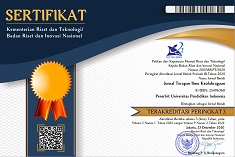Susu Coklat Lebih Unggul dari Jus Tomat, dan Minuman Olahraga Komersial dalam Pemulihan Otot Pasca Latihan Interval training?
Abstract
Latihan fisik adalah aktifitas seseorang yang bertujuan untuk meningkatkan atau memelihara kebugaran tubuh.. Tujuan penelitian ini adalah untuk mengetahui apakah terdapat pengaruh yang signifikan mengkonsumsi minuman susu coklat, jus tomat dan minuman olahraga dalam pemulihan otot pasca latihan interval training. Metode yang digunakan dalam penelitian ini adalah eksperimen dengan desain post-test only group design. Sample berjumlah 10 orang yang dibagi ke dalam empat grup eskperimen minuman yang berbeda dengan sampel yang sama. Grup eksperimen 1 sebagai control dengan air putih, grup eksperimen 2 diberi susu coklat, grup ke 3 diberi jus tomat, dan grup 4 diberi minumn olahraga. Instrumen yang digunakan dalam penelitian ini adalah Rast Test dan test kadar gula darah. Pada saat posttest semua sampel mengkonsumsi minuman sesuai dengan perlakuan setelah melakukan interval training. Analisis data menggunakan One-Way ANOVA dan uji Post Hoc-Tukey HSD untuk melihat pengaruh dan perbandingan antar kelompok. Hasil dari penelitian menunjukkan bahwa terdapat perbedaan yang signifikan rata-rata pemulihan otot dari berbagai instrument dibuktikan dengan nilai (sig) 0.00 < 0,05 dengan grup susu coklat memiliki pemulihan otot yang paling baik. Dapat disimpulkan bahwa terdapat pengaruh signifikan mengkonsumsi susu coklat dalam pemulihan otot pasca latihan interval training.
Keywords
Full Text:
PDFReferences
Busyairi, B., & Ray, H. R. D. (2018). Perbandingan Metode Interval Training dan Continuous Run terhadap Peningkatan Vo2max. Jurnal Terapan Ilmu Keolahragaan, 3(1), 76. https://doi.org/10.17509/jtikor.v3i1.10128
Ferguson-Stegall, L., McCleave, E. L., Doerner, P. G., Ding, Z., Wang, B., Dessard, B., … Ivy, J. L. (2010). Effects of Chocolate Milk Supplementation on Recovery from Cycling Exercise and Subsequent Time Trial Performance. Medicine & Science in Sports & Exercise, 42, 760. https://doi.org/10.1249/01.mss.0000386204.90806.51
Figure, S. (n.d.). No Title No Title_2015. https://doi.org/10.15713/ins.mmj.3
Flores, H. A., Shull, R. A., Schmitt, R., Randle, C., Sullivan, K., Blazer, C., … Astorino, T. A. (2011). Efficacy of Chocolate Soy Milk Ingestion on Supramaximal Exercise Performance. Medicine & Science in Sports & Exercise, 43(Suppl 1), 585. https://doi.org/10.1249/01.mss.0000401613.48260.76
Gilson, S. F., Saunders, M. J., Moran, C. W., Moore, R. W., Womack, C. J., & Todd, M. K. (2010). Effects of chocolate milk consumption on markers of muscle recovery following soccer training: a randomized cross-over study. Journal of the International Society of Sports Nutrition, 7(1), 19. https://doi.org/10.1186/1550-2783-7-19
Jabari, S. S., Jafari, S. M., Dehnad, D., & Shahidi, S. A. (2018). Changes in lycopene content and quality of tomato juice during thermal processing by a nanofluid heating medium. Journal of Food Engineering, 230, 1–7. https://doi.org/10.1016/j.jfoodeng.2018.02.020
Karp, J. R., & Johnston, J. D. (2006). Chocolate milk as a post -exercise recovery aid. International Journal of Sport Nutrition and Exercise Metabolism, 16(23), 78–91. https://doi.org/10.1097/00005768-200405001-00600
Lubis, R. F., & Siregar, N. S. (2017). Pengaruh Pemberian Semangka Terhadap Denyut Nadi Pemulihan Setelah Melakukan Aktivitas Fisik. Sains Olahraga: Jurnal Ilmiah Ilmu Keolahragaan, 1(1).
Lum, D., Tan, F., Pang, J., & Barbosa, T. M. (2016). Effects of intermittent sprint and plyometric training on endurance running performance. Journal of Sport and Health Science, (August). https://doi.org/10.1016/j.jshs.2016.08.005
Lunn, W. R., Pasiakos, S. M., Colletto, M. R., Karfonta, K. E., Carbone, J. W., Anderson, J. M., & Rodriguez, N. R. (2012). Chocolate milk and endurance exercise recovery: Protein balance, glycogen, and performance. Medicine and Science in Sports and Exercise, 44(4), 682–691. https://doi.org/10.1249/MSS.0b013e3182364162
MacInnis, M. J., & Gibala, M. J. (2017). Physiological adaptations to interval training and the role of exercise intensity. The Journal of Physiology, 595(9), 2915–2930.
Mackenzie, B. (2008). 101 Tests D’Évaluations.
Maughan, R. J., & Shirreffs, S. M. (2008). Development of individual hydration strategies for athletes. International Journal of Sport Nutrition and Exercise Metabolism, 18(5), 457–472.
Moreno, I. L., Pastre, C. M., Ferreira, C., de Abreu, L. C., Valenti, V. E., & Vanderlei, L. C. M. (2013). Effects of an isotonic beverage on autonomic regulation during and after exercise. Journal of the International Society of Sports Nutrition, 10(1), 2.
Pocock, G., Richards, C. D., Richards, D., & Richards, D. A. (2013). Human physiology. Oxford university press.
Ramos, J. S., Dalleck, L. C., Borrani, F., Beetham, K. S., Mielke, G. I., Dias, K. A., … Coombes, J. S. (2017). High-intensity interval training and cardiac autonomic control in individuals with metabolic syndrome: A randomised trial. International Journal of Cardiology, 245, 245–252.
Rashedi, E., & Nussbaum, M. A. (2017). Quantifying the history dependency of muscle recovery from a fatiguing intermittent task. Journal of Biomechanics, 51, 26–31. https://doi.org/10.1016/j.jbiomech.2016.11.061
Rismayanthi, C. (2014). Hubungan Antara Status Hidrasi dan Konsumsi cairan. Yogyayakarta. Fakultas Ilmu Keolahragaan.
Shirreffs, S. M. (2001). The optimal sports drink.
Shirreffs, S. M., & Sawka, M. N. (2011). Fluid and electrolyte needs for training, competition, and recovery. Journal of Sports Sciences, 29(SUPPL. 1). https://doi.org/10.1080/02640414.2011.614269
DOI: https://doi.org/10.17509/jtikor.v4i1.18527
Refbacks
- There are currently no refbacks.
Copyright (c) 2019 Jurnal Terapan Ilmu Keolahragaan

This work is licensed under a Creative Commons Attribution-NonCommercial-ShareAlike 4.0 International License.





